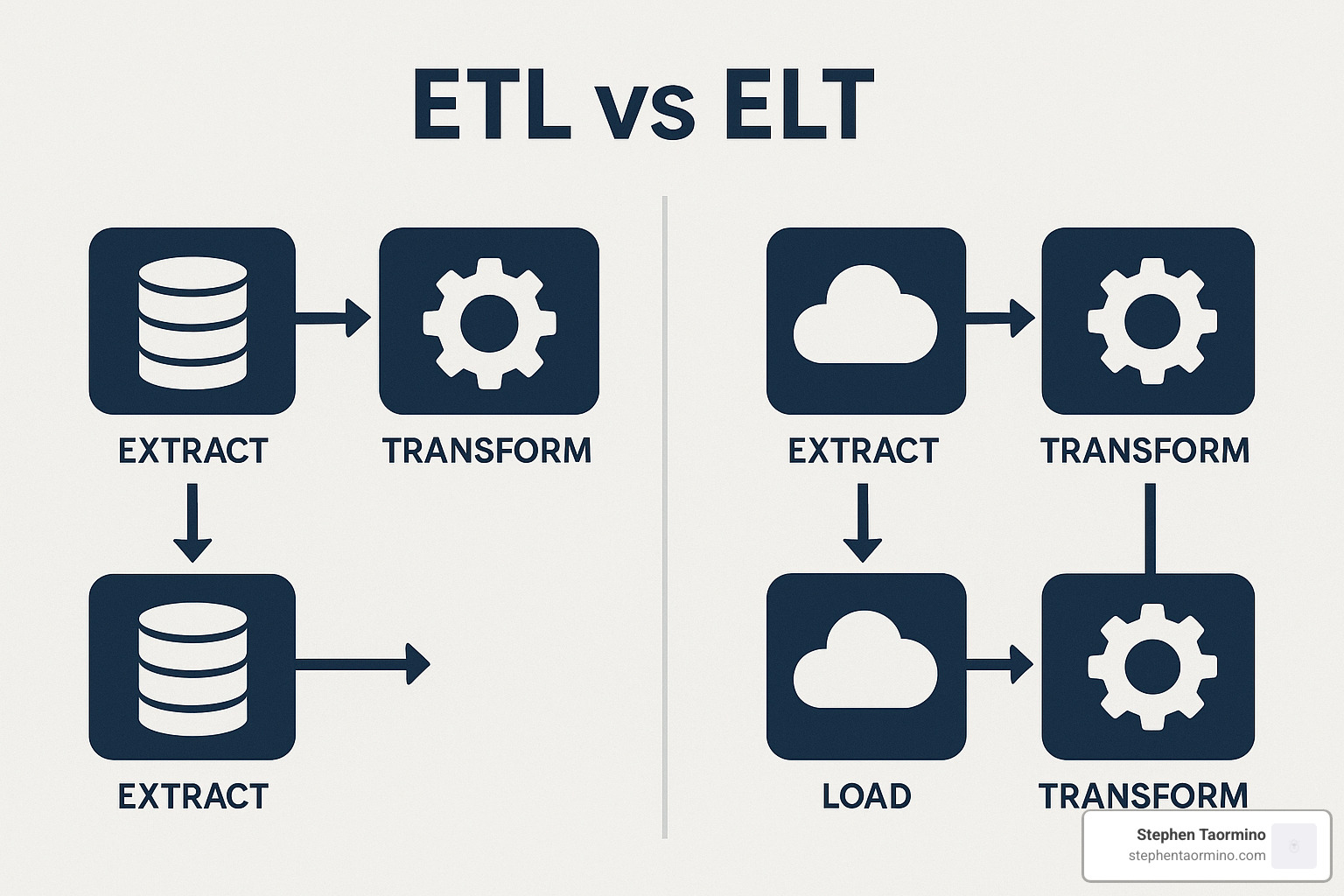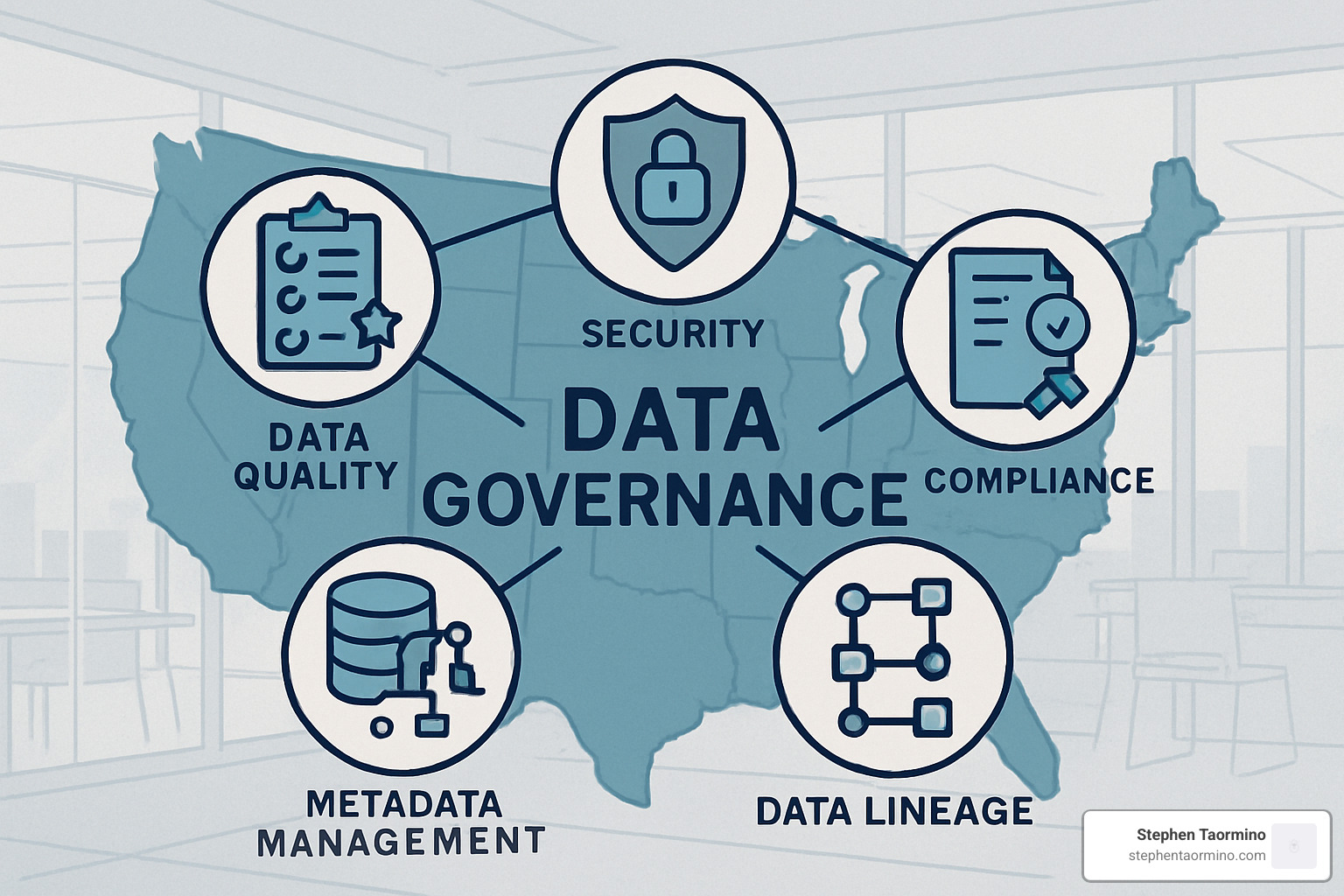Opening Value from Your Data Assets
A data change strategy is a comprehensive plan for converting raw data into valuable, analysis-ready information that drives business decisions. It’s the roadmap that guides how your organization collects, processes, standardizes, and uses data across systems.
Data Change Strategy in a Nutshell:
– Definition: A structured approach to convert raw data into usable formats
– Key Components: Data governance, technology infrastructure, change management, quality management, analytics capabilities
– Core Stages: Data findy, mapping, code generation, execution, and review
– Business Value: Improved decision-making, operational efficiency, competitive advantage
Businesses worldwide produce approximately 2.5 quintillion bytes of data every day, but without a proper change strategy, this vast resource remains largely untapped. According to research, organizations with effective data change initiatives are 26% more profitable and enjoy a 12% higher market valuation than their competitors.
The challenge isn’t collecting data—it’s changing it into actionable insights that can drive strategic decisions. Whether you’re struggling with inconsistent data formats, poor data quality (which costs organizations 20-30% of revenue), or difficulty integrating information from multiple systems, a robust data change strategy provides the foundation for data-driven success.
I’m Steve Taormino, President & CEO of CC&A Strategic Media, where I’ve helped organizations implement effective data change strategies that convert raw information into competitive advantages through my expertise in digital communications and marketing psychology.
Why Modern Organizations Can’t Ignore Data Change

Think of data as the new oil of our digital economy. Just like crude oil needs refining before it powers your car, raw data requires careful processing before it can fuel your business decisions.
When I talk with clients about their data challenges, I often see the same look of recognition when I explain that a data change strategy isn’t just some technical checkbox—it’s the engine that drives modern business success.
Definition & Importance
At its heart, data change transforms your raw information into something truly valuable. It’s like turning a pile of ingredients into a gourmet meal through several essential steps:
First comes cleansing, where we scrub away errors and duplicates that could spoil your analysis. Then structuring organizes chaotic information into clear, usable formats. Normalizing ensures everything uses the same scales and formats—like making sure all your temperature readings use the same unit of measurement. Enriching adds context and derived insights that make your data more meaningful, while integration brings everything together from across your organization.
Without these processes, your data remains like unrefined crude oil—full of potential but practically unusable. And the cost? Staggering. I’ve seen how McKinsey’s finding that poor data quality drains 20-30% of revenue plays out in real businesses. That’s not just a technical hiccup—it’s a major leak in your profit pipeline.
Business Impact & Key Statistics
The numbers tell a compelling story about why investing in a robust data change strategy pays off:
Companies that transform their data effectively are 26% more profitable than their industry peers. Not just marginally better—significantly more successful. They also enjoy a 12% higher market valuation, showing that investors recognize the value of good data practices too.
It’s no wonder that 99% of businesses are investing in data change projects. What’s particularly interesting is that 80% of digital champions start with strong data governance before attempting advanced analytics. They build the foundation first, then the house.
I recently worked with a financial services company that mirrors the success stories we’re seeing across industries. By rationalizing their IT data assets, they drove more than $400 million in savings. Even more impressive, they generated $2 billion in gains through additional revenues, reduced capital requirements, and streamlined operations.
Similarly, an insurance client is on track to grow their bottom line by 25% in target segments through their data initiatives. What’s remarkable isn’t that these successes happened—it’s that they’re becoming the norm for organizations that prioritize effective data change.
The message is clear: in today’s business environment, a thoughtful approach to changing your raw data into actionable insights isn’t just nice to have—it’s essential for survival and growth. Organizations that ignore this reality risk being left behind as their data-savvy competitors race ahead.
Crafting a Winning Data Change Strategy

Let’s face it—turning mountains of raw data into business gold doesn’t happen by accident. Creating a data change strategy is like planning a cross-country road trip: you need a clear destination, the right vehicle, and a thoughtful route to avoid dead ends.
I’ve helped dozens of organizations steer this journey, and I’ve found that success comes from blending technical know-how with genuine business understanding. Here’s how you can chart your own path forward:
Five-Stage Process From Findy to Optimization
Think of your data change strategy as a natural progression that builds momentum with each step:
Start with Data Findy & Profiling – this is where you roll up your sleeves and get curious. Talk to the people who actually use your data day-to-day (they often have insights no dashboard will show you). Use profiling tools to understand what you’re working with, spotting patterns and problems before they derail your efforts.
Next comes Data Mapping & Rule Definition, where you connect the dots between what you have and what you need. This is like creating the blueprint for your data’s change journey. Clear mapping decisions now save countless headaches later, so document everything—your future self will thank you.
The Code Generation & Development stage turns your plans into action. Here’s where technical expertise shines, creating the engines that will power your data change. Smart teams build reusable components rather than starting from scratch each time.
During Execution & Processing, your strategy comes to life. Whether you’re running overnight batch processes or real-time changes, keeping a watchful eye on performance is key. Good error handling isn’t just technical best practice—it’s peace of mind.
Finally, Review & Continuous Improvement closes the loop. The best strategies evolve based on results and feedback. As one client told me after implementing this approach: “We’re not just fixing data problems anymore—we’re preventing them.”
Aligning Data Change Strategy With Business Goals
A technically perfect data change strategy that doesn’t serve business needs is like a sports car with nowhere to go. Here’s how to ensure your efforts drive real business value:
Define Clear Business Objectives by starting with the “why” behind your data efforts. I’ve seen too many organizations invest in sophisticated data pipelines without first asking what business problems they’re trying to solve. Get specific about the outcomes you want, then work backward.
Select Appropriate Metrics that matter to decision-makers. Technical metrics like processing time have their place, but business leaders care about how data changes translate to revenue, customer satisfaction, or operational efficiency. Create dashboards that speak both languages.
Apply a Human-Centered Change Approach because, ultimately, data strategies succeed or fail based on people. I’ve found the Maslow change model incredibly useful here—addressing basic needs for security and understanding before expecting innovation. When people understand why change matters to them personally, resistance melts away.
Secure Executive Sponsorship from leaders who can champion your vision when challenges arise (and they will). As one client’s CEO told his team: “This isn’t IT’s data project—it’s our business change.” That simple reframing shifted everything.
According to McKinsey’s latest research on successful changes, organizations that connect data initiatives to clear business outcomes are 1.7 times more likely to report successful changes.
A winning data change strategy isn’t just about technology—it’s about creating a bridge between what’s technically possible and what’s commercially valuable. When you align these elements, data becomes your competitive advantage rather than just another corporate asset.
Techniques, Frameworks & Tooling That Scale

When you’re ready to put your data change strategy into action, you’ll need the right techniques and tools that can grow with your business. Think of it like building a house—you need both the right blueprint and the right tools to create something that will last.
ETL vs ELT: Picking the Right Framework
I often tell my clients that choosing between ETL and ELT is like deciding between cooking at home or getting takeout and reheating it. Both get you a meal, but the process and results differ in important ways.
Extract-Transform-Load (ETL) is the traditional approach where you transform your data before it reaches its final destination. It’s like preparing all your ingredients before putting them in the fridge. Extract-Load-Transform (ELT), on the other hand, loads the raw data first and transforms it inside your warehouse—more like storing groceries immediately and cooking later when needed.
Here’s how they stack up against each other:
| Characteristic | ETL (Extract-Transform-Load) | ELT (Extract-Load-Transform) |
|---|---|---|
| Process Flow | Data is transformed before loading into the target | Data is loaded first, then transformed within the target system |
| Best For | Smaller data volumes, complex changes | Big data, cloud-native architectures |
| Processing Location | Separate change server or service | Within the target database/warehouse |
| Latency | Higher (batch-oriented) | Lower (can support near real-time) |
| Scalability | Limited by change server capacity | Leverages target system’s computing power |
| Storage Requirements | Lower (only transformed data is stored) | Higher (stores both raw and transformed data) |
| Schema Flexibility | Schema-on-write (rigid) | Schema-on-read (flexible) |
| Compliance & Security | May offer better control for sensitive data | Requires additional security measures for raw data |
| Cost Model | Higher upfront investment | Pay-as-you-go scaling (in cloud implementations) |
I recently worked with a financial services company that made the switch from ETL to ELT. They told me, “We consolidated 600 legacy systems into a data lake and couldn’t believe how much faster we could access our data.” Their story isn’t unique—many organizations are making this shift as cloud warehouses become more powerful and cost-effective.
Your choice ultimately depends on your specific needs. If you’re handling sensitive healthcare data with strict compliance requirements, ETL might give you the control you need. But if you’re building a flexible analytics platform where you’re not sure what questions you’ll need to answer tomorrow, ELT keeps more options open.
Selecting and Integrating Best-Fit Tools
Finding the right tools for your data change strategy is a bit like assembling your kitchen. You need the right mix of appliances that work well together and fit your cooking style.
Data smoothing helps you remove the noise from your data to see the real patterns underneath. Aggregation rolls up detailed information into meaningful summaries. Normalization puts different data on the same scale so you can compare apples to apples. And feature engineering—one of my favorite techniques—creates new data points that often reveal the most valuable insights.
When it comes to the actual tools, you’ll need to consider whether traditional ETL platforms like Informatica or Talend fit your needs, or if you’re ready for modern ELT approaches using tools like dbt models for in-warehouse changes. Workflow orchestration tools like Apache NiFi flows can connect these pieces into coherent pipelines, while low-code automation options make these capabilities accessible to more of your team.
The best tool selection comes down to a few key factors:
Scalability is non-negotiable—your data will grow, and your tools need to grow with it. Integration capabilities determine how easily your tools connect to your existing systems. And don’t overlook usability—the most powerful tool is useless if your team can’t or won’t use it.
I always recommend implementing version control for your change logic and setting up CI/CD pipelines for testing and deployment. These software development practices are just as valuable for data work, creating a foundation for reliable, repeatable processes.
One healthcare client told me, “We spent months evaluating tools based on features, but in the end, the tool that integrated best with our existing systems delivered the most value.” This highlights an important truth: sometimes the “best” tool on paper isn’t the best tool for your specific situation.
The right combination of techniques and tools creates a solid foundation for your data change strategy—one that can evolve as your business needs change. For more information about selecting the right services for your needs, check out More info about x services.
The goal isn’t just to transform data—it’s to transform your business through better insights and decisions. The right tools make that journey possible.
Governance, Security & Change-Management Problems

Let’s face it – you can build the most technically brilliant data change strategy in the world, but without solid governance, security, and change management, it might still crash and burn. I’ve seen this happen more times than I’d like to admit. The good news? These challenges are entirely manageable with the right approach.
Overcoming Common Pitfalls
When organizations stumble with their data initiatives, the same issues tend to pop up again and again. Here’s how to steer around them:
Those pesky legacy data silos can feel like concrete walls between departments. Rather than attempting to demolish everything at once (which rarely works), consider implementing data virtualization layers that create bridges between systems. This gives you unified access without requiring an immediate, high-risk migration. I’ve found that starting with one high-value use case that shows tangible benefits is far more effective than trying to boil the ocean.
Many teams dramatically underestimate complexity until they’re knee-deep in the project. Before diving in, invest time in thorough data profiling and small proof-of-concept projects. Using agile methodologies lets you deliver value incrementally while learning and adapting to the complexity as you go. One financial services client of mine saved millions by taking this staged approach rather than committing to a massive project upfront.
Then there’s the human factor – resistance to change. People aren’t naturally opposed to improvement, but they are wary of disruption and uncertainty. Develop a thoughtful change management strategy that addresses concerns early and builds genuine buy-in. I’ve seen tremendous success when organizations identify and empower champions across departments who can translate the benefits into terms that resonate with their colleagues.
Without clear ownership, data initiatives often drift aimlessly. Establish a governance framework with defined roles and decision rights from the start. Consider appointing a Chief Data Officer or dedicated data stewards to drive accountability. As one healthcare executive told me, “Once we knew who owned what, everything else started falling into place.”
Finally, many organizations implement changes but lack adequate monitoring systems. Problems often go undetected until they’ve caused significant damage. Implement continuous monitoring of both data quality and pipeline performance with clear metrics and thresholds for automated alerts. This creates a safety net that catches issues before they become crises.
According to McKinsey research, even successful changes typically realize only 67% of their potential financial impact—often due to these very challenges. By tackling these issues head-on, you can capture significantly more value from your data change strategy.
Ensuring Compliance & Trust at Scale
As your data operations grow, governance and security become not just regulatory requirements but critical business enablers:
A robust data governance framework forms the backbone of trustworthy data operations. This means assigning clear data stewardship responsibilities, documenting metadata (including definitions and lineage), establishing usage policies, and implementing quality management processes. Without this foundation, organizations struggle to maintain consistency as they scale.
Security measures must be baked into your strategy from day one, not bolted on later. Implement role-based access controls following least privilege principles—people should only access what they need. Encrypt sensitive data both in transit and at rest. Maintain comprehensive audit trails of all access and changes. For particularly sensitive information, consider techniques like masking or tokenization to protect privacy while preserving analytical value.
Regulatory compliance requirements continue to multiply worldwide. Start by mapping applicable regulations like GDPR, HIPAA, or CCPA to your data processes. Maintain clear documentation of your compliance measures—regulators love a paper trail. Conduct regular privacy impact assessments when developing new change processes. And ensure you can efficiently respond to data subject rights requests like access or deletion.
Perhaps most importantly, focus on building trust throughout your organization. Be transparent about how data is transformed and used. Ensure consistent, repeatable change processes that deliver reliable results. Validate transformed data against clear quality criteria. And provide appropriate self-service access to trusted data products—making insights available to those who need them.
I’ve observed that a strong governance and security foundation doesn’t just reduce risk—it actually accelerates value creation by increasing confidence in transformed data. It’s telling that 80% of digital champions invest in data governance capabilities first, creating a solid foundation before building advanced analytics.
This foundation of trust turns data from a potential liability into your organization’s most valuable asset.
Future Trends & Measuring ROI

The world of data change isn’t standing still. As someone who’s helped numerous organizations steer this landscape, I’ve seen how quickly things evolve. Let’s explore what’s coming and—perhaps more importantly—how to measure if your efforts are actually paying off.
Calculating ROI of Your Data Change Strategy
When clients ask me about ROI for their data change strategy, I always remind them that we need to look beyond simple cost metrics. The real value shows up across multiple dimensions of your business:
Direct cost savings often provide the most visible return. One financial services client I worked with achieved a remarkable $400 million in savings just by rationalizing their IT data assets. Think about what you’re spending on maintaining legacy systems, manual processing, and fixing data errors—these costs can drop dramatically with the right strategy.
Revenue growth might be even more exciting. I’ve seen companies transform their bottom line through better data. An insurance client projected 25% bottom-line growth in their target segments once they implemented their data initiatives. When you can see customers more clearly, target them more precisely, and develop products that truly meet their needs, sales naturally follow.
Operational efficiency gains might be less flashy but are equally valuable. One of my favorite success stories involved a team that automated their reporting process, saving 25-40 hours of preparation time for each client meeting. Imagine what your team could accomplish with that kind of time back in their day!
The key to measuring ROI effectively lies in establishing clear metrics before you begin. I recommend tracking both technical indicators (data quality scores, processing times) and business outcomes (decision speed, user adoption). Set up dashboards that give you visibility into these metrics, and schedule regular reviews to assess progress.
McKinsey research shows successful changes typically realize only 67% of their potential financial impact. By measuring rigorously, you’ll identify opportunities to capture that missing 33%—turning a good data change strategy into a great one.
Emerging Trends in Data Change
The tools and techniques we use to transform data are evolving rapidly. Here are the developments I’m most excited about:
AI-driven change is revolutionizing how we work with data. Rather than manually defining change rules, AI can now detect quality issues, suggest corrections, and even generate metadata automatically. For one client, this reduced their data preparation time by over 60%, allowing their analysts to focus on insights rather than cleaning.
Real-time change capabilities are becoming essential in our world. Organizations are shifting from batch processing to stream-based architectures that transform data on the fly. This enables immediate insights and faster decision-making—critical advantages in competitive markets.
Lakehouse architectures are bridging the gap between data lakes and warehouses, giving you the best of both worlds. These unified platforms support both structured and unstructured data while providing the performance and governance features businesses need. I’ve seen organizations reduce their data architecture complexity by 40% with this approach.
Low-code/no-code change tools are democratizing data work. With visual interfaces and drag-and-drop pipeline creation, business users can now participate directly in the change process. One manufacturing client empowered their operations team to build their own data pipelines, dramatically accelerating their analytics initiatives.
DataOps practices are bringing software engineering discipline to data work. By applying continuous integration, automated testing, and monitoring to data pipelines, organizations can achieve greater reliability and efficiency. Teams using these practices typically see a 70% reduction in data incidents.
These trends point toward a future where data change becomes more accessible, automated, and integrated with business processes. The organizations that accept these developments will be best positioned to extract maximum value from their data assets.
As we steer these changes together, I’m committed to helping you build a data change strategy that not only meets today’s needs but positions you for tomorrow’s opportunities. The future belongs to organizations that can turn data into insights—and insights into action—faster and more effectively than their competitors.
Frequently Asked Questions about Data Change Strategy
What’s the difference between ETL, ELT, and “data change strategy”?
When clients ask me about these terms, I like to use a simple analogy: ETL and ELT are specific tools in your toolbox, while a data change strategy is the complete blueprint for your home renovation project.
ETL (Extract, Transform, Load) and ELT (Extract, Load, Transform) represent technical approaches to processing your data. They’re important components, but they’re just pieces of the bigger picture.
Your data change strategy, on the other hand, encompasses everything from the people involved to the governance structures, processes, and technologies you’ll employ. It answers the crucial questions of why, when, and how you’ll transform your raw data into valuable insights.
ETL works by changing your data before loading it into your target system – perfect for complex changes or sensitive information. ELT takes the opposite approach, loading raw data first and then changing it within the target system, which often gives you more flexibility in cloud environments.
A well-designed strategy helps you determine which approach makes sense for different scenarios in your organization – because one size definitely doesn’t fit all when it comes to data.
How long does a typical data change initiative take?
I often smile when I get this question because the honest answer is: it depends – but I can give you a realistic framework based on what I’ve seen work.
Rather than viewing data change as a one-off project with a finish line, successful organizations approach it as an ongoing capability that evolves with their business. Here’s a general timeline I’ve observed with clients:
Your strategy development typically takes 1-3 months to assess where you are, define clear objectives, and create your roadmap. Initial proof-of-concept projects can deliver results in as little as 2-4 weeks per use case, giving you quick wins to build momentum.
The foundation phase – establishing governance, selecting tools, implementing core infrastructure – usually requires 3-6 months of focused work. From there, implementing major use cases might take 2-6 months each, with several running in parallel as you scale.
One financial institution I worked with found their cross-functional teams could deliver meaningful wins in just 3-4 months per domain, while their overall change journey continued for years.
The key is structuring your data change strategy to deliver incremental value throughout the journey. This approach builds confidence, maintains momentum, and ensures you’re not waiting months or years before seeing returns on your investment.
How do we measure success and maintain momentum?
Measuring success and keeping your data initiatives moving forward requires both art and science. I’ve found the most successful organizations take a multi-layered approach:
First, define clear success metrics that matter to your business. These should include tangible business outcomes like revenue growth or cost reduction, data quality improvements such as accuracy and completeness, operational efficiencies, and user adoption rates.
Regular checkpoints help keep everyone aligned and accountable. Weekly team reviews focus on progress and removing obstacles, while monthly steering committee meetings highlight key metrics. Quarterly business impact assessments and annual strategy reviews ensure you’re still heading in the right direction.
Perhaps most importantly, celebrate and communicate wins throughout your organization. I’ve seen how highlighting successful use cases, recognizing team contributions, and connecting change achievements to business outcomes can energize an entire company.
As Rob Casper, Chief Data Officer at a major financial institution, wisely noted: “Celebrating small, early successes is the single most powerful motivator to build momentum in a change.”
To maintain momentum long-term, establish clear ownership for ongoing initiatives, continuously engage stakeholders for feedback, provide regular training opportunities, and evolve your roadmap based on lessons learned. This approach demonstrates the tangible value of your data change strategy while building the foundation for sustainable success.
Change is a journey, not a destination. By measuring what matters and celebrating progress along the way, you’ll create the positive momentum needed to drive lasting change in how your organization leverages data.
Conclusion
Implementing a successful data change strategy isn’t just about fancy technology—it’s about building a foundation that transforms how your entire organization makes decisions and competes in the marketplace.
Throughout this guide, we’ve explored what makes data change truly work in the real world. The most effective strategies don’t happen by accident—they’re carefully designed with several key elements:
First, your data initiatives must clearly connect to actual business goals. When your data work directly supports what matters to your company, you create tangible value that executives can see and support.
Second, you need a structured approach that takes you from initial data findy all the way through to ongoing improvements. This journey doesn’t happen overnight, but each step builds meaningful progress.
The right techniques and tools matter tremendously. As your data needs grow (and they will!), your systems need to scale alongside them without breaking the bank or creating technical debt.
Strong governance and security aren’t just compliance checkboxes—they’re the foundation of trust in your data. Without them, even the most sophisticated analytics will be viewed with skepticism.
Perhaps most overlooked is the human element. The best data strategy in the world will fail if your people don’t understand it, support it, or know how to use it. Change management isn’t a nice-to-have; it’s essential.
Finally, you need clear ways to measure progress and demonstrate ROI. Numbers tell the story of your success and help maintain momentum when challenges arise.
The truth is, becoming truly data-driven isn’t a destination with a finish line. It’s an ongoing journey where each success builds on previous ones, and each challenge teaches valuable lessons. By approaching data change strategically, you open up the full potential of what might be your organization’s most valuable asset—your data.
At CC&A Strategic Media, I’ve seen how thoughtful data change strategies drive remarkable business growth. Through our work in marketing psychology and digital change, we’ve helped organizations turn their data from a confusing mess into their competitive superpower.
Data change is a journey that requires ongoing attention and investment. By embracing this mindset and following the principles we’ve discussed, your organization can use data to make smarter decisions, create better customer experiences, and achieve breakthrough results.
For more insights on digital change strategy and leveraging data for business growth, explore our video resources or reach out to learn how we might help you.
